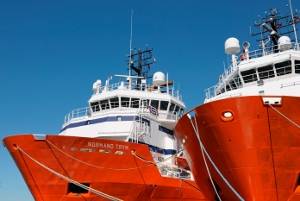Solstad Offshore Converted by Gibdock
Solstad Offshore is redeploying two platform supply vessels as potable water and fuel oil carriers to service Brazil’s offshore rig market for Petrobras, after completion of a major conversion project at Gibdock.
The four week project saw the 2006-built Normand Trym (3,326 dwt) in drydock and the 2008-built Normand Vibran (3,376 dwt) alongside at the Gibraltar yard, in order that mud tanks on each vessel could be converted to store 1500m3 of fresh water storage, with other tanks converted for 800m3 of fuel oil carriage. At time of writing, the 242.8 ft long by 52.5 ft wide UT755 LN vessels were en route to Brazilian waters.
“We have undertaken routine repair work for Solstad in the past, building up a solid relationship with a high value client,” said Richard Beards, Gibdock Commercial Director. “However, this is the first time we have undertaken one of their conversion projects.
“This was an extensive job in terms of planning and complexity, while limited access to tanks made welding challenging and restricted the number of men on board at any given time, dictating the pace of work.”
As well as general steelwork, the job included installation of steel tank floors, which were prefabricated by Gibdock in order to minimize the need to weld in position. A 600mm cofferdam arrangement needed to be built into the tank bottoms on both vessels to satisfy class requirements. All converted tanks were blasted and coated, with a specialized 500 micron thick Sigma paint applied in a single operation. The job also saw the No:1A ballast water tank (Forepeak Tank) blasted and coated for carriage of fresh water.
Gibdock vessel superintendant Steve Davis said that the modernization of existing pipe and valve work and the installation of new pipe work for fresh water carriage proved a demanding task, involving galvanization. “These are sister ships, but it is fair to say that the pipe work on board Normand Trym was more complex than was the case with Vibran,” he said.
“This type of conversion project is not common, either in general or for Gibdock,” Davis added. “As well as the extensive pre-planning and pre-fabrication, it required considerable adaptability to deal with the structural work.”
In addition to the above work, Gibdock carried out Normand Trym’s scheduled dry-docking at the same time. On completion of the conversion project, considerable attention was paid to ensuring that all signage on board both ships would meet Port State Control conditions for operating in Brazilian waters.











